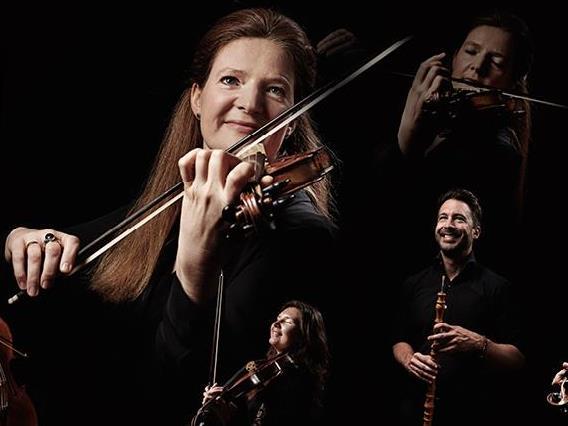Image: Violinist Rachel Podger and members of the Orchestra of the Age of Enlightenment. Photo (c) Shane Reid.
Melbourne audiences have been blessed over the past week by the visits of two British reigning queens of early music and the Baroque, with a recital by Dame Emma Kirkby on Wednesday and two performances by the Age of Enlightenment directed by violinist Rachel Podger. The period-instrument Orchestra of the Age of Enlightenment was formed in 1986. It does not have a permanent resident conductor, preferring to work with different leaders for each project. The core of its repertoire is from the historical period after which the ensemble is named. On Saturday night, 19 members of the OAE under Podger’s fresh and ebullient direction provided more than a fair share of Sturm und Drang (Storm and Stress) in a neatly conceived program of two concertos and two symphonies written over the decade 1765 to 1775. The program comprised Haydn’s 26th Symphony in D minor Lamentatione Hob 1:26, Mozart’s first and fifth Violin Concertos, K207 and 219 ‘Turkish’ and Johann Christian Bach’s Symphony in G minor, Op 6 No 6.
As the ensemble walked on stage, it was pleasing to see so many mature musicians; local baroque ensembles tend to be comprised of young adults who look great but may lack experience. Here were musicians who had been playing this repertoire in historically informed style all their careers with confidence.
In an introduction to the first concerto, Podger praised the acoustic of Elisabeth Murdoch Hall within the Melbourne Recital Centre sharing her conviction that it was so far the ensemble’s favourite on their national tour for Musica Viva Australia. For this performance the side sound baffles were removed entirely, providing a resonant acoustic normally reserved for vocal recitals. It was clear throughout that the ensemble and soloist, standing for both symphonies, were savouring their sound in this warm, timber-clad environment. Throughout the entire performance the sound of the ensemble was characterised by technical brilliance, a clear vision of form, excellent balance, fine intonation, an abundance of sharply focused rhetoric, exquisite elegance, with light and shade in phrasing.
The highlight for me was the opening symphony, Haydn’s 26th , written only two years after his having been elevated to the role of Kapellmeister for the Esterházy family, a position that was to have crucial importance in the development of his European and English reputation. The work’s association with Christ’s Passion, incorporating plainchant in the opening movement’s second theme, is reflected in its dark and solemn colours in D minor and its popular name ‘Lamentatione’. Here we heard some of the finest playing of the concert with a pastoral spaciousness carried in the Adagio and delightful wit and insouciant charm conveyed in the Minuet e Trio.
Johann Christian Bach ‘the English Bach’ influenced Mozart when he visited London as a child. The three–movement dark and dramatic Symphony in G minor that became a popular in Georgian London was written after his move to the English capital in 1762. It received a theatrically gripping performance on this occasion with telling attention to the smallest of details.
Mozart’s five violin concertos, written over two years when he was a teenager in Salzburg, are hardly deeply profound musical statements and along with so much of this composer’s early output have achieved an almost mythical status of purity and perfection. This was the repertoire that Karajan selected for the 13-year-old Anne-Sophie Mutter for her first concerto performances with the Berlin Philharmonic. So it was a refreshing contrast to hear the first and fifth performed by Podger with little vibrato, a lightness of touch and a genuine love and clear understanding of the innocent charms of both compositions. There were some intonation issues from the soloist in the fifth Concerto in the ‘lemony’ and astringent key of A major, but nothing overly concerning. The cadenzas, both elegant and stylish, were by Podger herself, “inspired after meeting Robert Levin” an American Mozart scholar. Podger played a violin made in Genoa in 1739 by Pesarinius, a later student of Antonio Stradivari. Her light Classical bow is by Pieter Affortit based on a bow from around 1780.
There is one further performance on this tour in Perth on Tuesday night. If you can still buy a ticket, do so. Highly recommended.
Rating: 4 ½ stars out of 5
Orchestra of the Age of Enlightenment
Rachel Podger, violinist/director
Elisabeth Murdoch Hall
Melbourne Recital Centre
Saturday, 18 November, 2017





